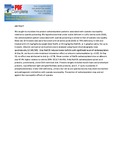Carbamoylation correlates of cyanate neuropathy and cyanide poisoning: relevance to the biomarkers of cassava cyanogenesis and motor system toxicity
Date
2013-12-02Author
KIMANI, SAMUEL
Moterroso, Victor
Lasarev, Mike
Kipruto, Sinei
BUKACHI, FRED
Maitai, Charles
David, Larry
Tshala-Katumbay, Desire
Type
ArticleLanguage
enMetadata
Show full item recordAbstract
We sought to elucidate the protein carbamoylation patterns associated with cyanate neuropathy relative to cyanide poisoning. We hypothesized that under a diet deficient in sulfur amino acids (SAA), the carbamoylation pattern associated with cyanide poisoning is similar to that of cyanate neuropathy. Male rats (6–8 weeks old) were fed a diet with all amino acids (AAA) or 75%-deficiency in SAA and treated with 2.5 mg/kg/body weight (bw) NaCN, or 50 mg/kg/bw NaOCN, or 1 μl/g/bw saline, for up to 6 weeks. Albumin and spinal cord proteins were analyzed using liquid chromatography mass spectrometry (LC-MS/MS). Only NaOCN induced motor deficits with significant levels of carbamoylation. At Day 14, we found a diet-treatment interaction effect on albumin carbamoylation (p = 0.07). At Day 28, no effect was attributed to diet (p = 0.71). Mean number of NaCN-carbamoylated sites on albumin was 47.4% higher relative to vehicle (95% CI:16.7-86.4%). Only NaOCN carbamoylated spinal cord proteins, prominently, under SAA-restricted diet. Proteins targets included myelin basic and proteolipid proteins, neurofilament light and glial fibrillary acidic proteins, and 2', 3' cyclic-nucleotide 3'-phosphodiesterase. Under SAA deficiency, chronic but not acute cyanide toxicity may share biomarkers and pathogenetic similarities with cyanate neuropathy. Prevention of carbamoylation may protect against the neuropathic effects of cyanate.
Citation
SpringerPlus 2013, 2:647 (2 December 2013)Publisher
University of Nairobi
Collections
- Faculty of Health Sciences (FHS) [10377]

